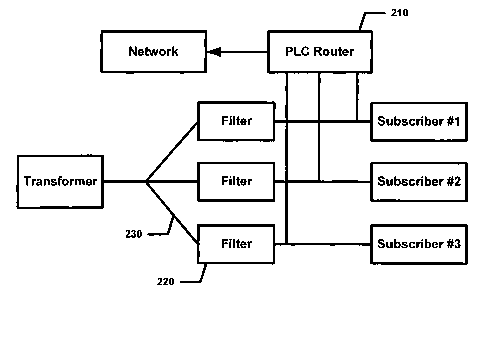Some of the information on this Web page has been provided by external sources. The Government of Canada is not responsible for the accuracy, reliability or currency of the information supplied by external sources. Users wishing to rely upon this information should consult directly with the source of the information. Content provided by external sources is not subject to official languages, privacy and accessibility requirements.
Any discrepancies in the text and image of the Claims and Abstract are due to differing posting times. Text of the Claims and Abstract are posted:
| (12) Patent Application: | (11) CA 2397954 |
|---|---|
| (54) English Title: | METHOD OF ISOLATING DATA IN A POWER LINE COMMUNICATION NETWORK |
| (54) French Title: | PROCEDE D'ISOLATION DE DONNEES DANS UN RESEAU DE COMMUNICATIONS A LIGNE ELECTRIQUE |
| Status: | Deemed Abandoned and Beyond the Period of Reinstatement - Pending Response to Notice of Disregarded Communication |
| (51) International Patent Classification (IPC): |
|
|---|---|
| (72) Inventors : |
|
| (73) Owners : |
|
| (71) Applicants : |
|
| (74) Agent: | SMART & BIGGAR LP |
| (74) Associate agent: | |
| (45) Issued: | |
| (86) PCT Filing Date: | 2001-01-19 |
| (87) Open to Public Inspection: | 2001-07-26 |
| Availability of licence: | N/A |
| Dedicated to the Public: | N/A |
| (25) Language of filing: | English |
| Patent Cooperation Treaty (PCT): | Yes |
|---|---|
| (86) PCT Filing Number: | PCT/US2001/001810 |
| (87) International Publication Number: | WO 2001054297 |
| (85) National Entry: | 2002-07-22 |
| (30) Application Priority Data: | ||||||
|---|---|---|---|---|---|---|
|
Isolating data in a power line communications system. Although plural
subscribers receive electric power distributed from a common distribution
transformer, it is desirable to isolate their branch lines from one another
when those branch lines are used to conduct data communications as a
supplement to electric power delivery. This isolation of branch lines is
implemented in a centralized way at the distribution transformer, or
alternatively, in a distributed way at each subscriber's premises. These
implementations are made using low pass filters (which pass the power but
block the data) and power line communications routers or power line
communications repeaters.
L'invention concerne l'isolation de données dans un système de communications à ligne électrique. Bien que l'alimentation électrique de plusieurs abonnés puisse être distribuée à partir d'un transformateur de distribution commun, il est souhaitable d'isoler leurs lignes de dérivation les unes des autres lorsqu'on les utilise pour communiquer des données en plus de distribuer de l'électricité. L'isolation des lignes de dérivation est mise en place de manière centralisée au niveau du transformateur de distribution, ou de manière distribuée au niveau de chaque local d'abonné. Ces mises en oeuvre sont effectuées à l'aide de filtres passe-bas (qui laissent passer l'électricité mais bloquent les données) et de routeurs de communication à ligne électrique ou de répéteurs de communication à ligne électrique.
Note: Claims are shown in the official language in which they were submitted.
Note: Descriptions are shown in the official language in which they were submitted.

2024-08-01:As part of the Next Generation Patents (NGP) transition, the Canadian Patents Database (CPD) now contains a more detailed Event History, which replicates the Event Log of our new back-office solution.
Please note that "Inactive:" events refers to events no longer in use in our new back-office solution.
For a clearer understanding of the status of the application/patent presented on this page, the site Disclaimer , as well as the definitions for Patent , Event History , Maintenance Fee and Payment History should be consulted.
| Description | Date |
|---|---|
| Letter Sent | 2009-04-16 |
| Inactive: Correspondence - Transfer | 2008-11-28 |
| Inactive: Office letter | 2008-10-14 |
| Letter Sent | 2008-06-26 |
| Time Limit for Reversal Expired | 2007-01-19 |
| Application Not Reinstated by Deadline | 2007-01-19 |
| Inactive: Abandon-RFE+Late fee unpaid-Correspondence sent | 2006-01-19 |
| Deemed Abandoned - Failure to Respond to Maintenance Fee Notice | 2006-01-19 |
| Letter Sent | 2002-12-10 |
| Inactive: Cover page published | 2002-12-09 |
| Inactive: Notice - National entry - No RFE | 2002-12-05 |
| Correct Applicant Requirements Determined Compliant | 2002-12-05 |
| Application Received - PCT | 2002-09-23 |
| Inactive: Single transfer | 2002-09-20 |
| Amendment Received - Voluntary Amendment | 2002-09-20 |
| Amendment Received - Voluntary Amendment | 2002-07-23 |
| National Entry Requirements Determined Compliant | 2002-07-22 |
| Application Published (Open to Public Inspection) | 2001-07-26 |
| Abandonment Date | Reason | Reinstatement Date |
|---|---|---|
| 2006-01-19 |
The last payment was received on 2005-01-10
Note : If the full payment has not been received on or before the date indicated, a further fee may be required which may be one of the following
Please refer to the CIPO Patent Fees web page to see all current fee amounts.
| Fee Type | Anniversary Year | Due Date | Paid Date |
|---|---|---|---|
| Basic national fee - standard | 2002-07-22 | ||
| MF (application, 2nd anniv.) - standard | 02 | 2003-01-20 | 2002-07-22 |
| Registration of a document | 2002-09-20 | ||
| MF (application, 3rd anniv.) - standard | 03 | 2004-01-19 | 2003-12-30 |
| MF (application, 4th anniv.) - standard | 04 | 2005-01-19 | 2005-01-10 |
| Registration of a document | 2008-03-31 |
Note: Records showing the ownership history in alphabetical order.
| Current Owners on Record |
|---|
| CURRENT TECHNOLOGIES, LLC |
| Past Owners on Record |
|---|
| PAUL KLINE |